What a week! It started with the Amiga Ireland 2019 meetup in Athlone and ended with SWAG’s Workbench 2019 club event in Chipping Sodbury with visits to Cardiff, in Wales and Aberdeen in Scotland sandwiched in between. As I’m typing this update in London, England I can truly say I’ve travelled to all the counties that make up the geographic area of Britain and Ireland.
Amiga Ireland 2019
Following an uneventful journey from New Zealand to London, even transiting through Los Angeles was relatively painless this time, I made my way to Cardiff by coach from Heathrow airport to meet up with Matthew Leaman of AmigaKit. When I’m in Cardiff I usually have the pleasure of staying with Matthew’s parents, Helen & Terry and their Old English sheep dog Henry. 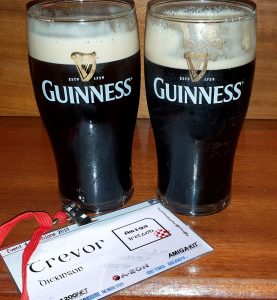 After spending a day in Cardiff to catch up on recent A-EON Technology business and recover from my Summer to Winter flight, Matthew, Christopher Follett (AmigaKit’s technician) and I flew to Dublin to attend the Amiga Ireland show which was being sponsored by both A-EON and AmigaKit for the third year running. We met up with David Pleasance, the former Commodore UK Managing Director, in Dublin airport for the 2-1/2 hour drive to Athlone. Unfortunately, RJ Mical who had planned to fly in from California to attend the show for the first time, had to call off at the last minute because, according to RJ, his doctors wanted to bring forward an important medical appointment for “patching his intuition library” and despite his pleading they refused to delay the treatment to let him travel.
After spending a day in Cardiff to catch up on recent A-EON Technology business and recover from my Summer to Winter flight, Matthew, Christopher Follett (AmigaKit’s technician) and I flew to Dublin to attend the Amiga Ireland show which was being sponsored by both A-EON and AmigaKit for the third year running. We met up with David Pleasance, the former Commodore UK Managing Director, in Dublin airport for the 2-1/2 hour drive to Athlone. Unfortunately, RJ Mical who had planned to fly in from California to attend the show for the first time, had to call off at the last minute because, according to RJ, his doctors wanted to bring forward an important medical appointment for “patching his intuition library” and despite his pleading they refused to delay the treatment to let him travel.
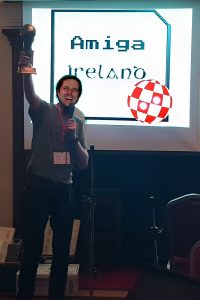
Matthew ferried us safely to Athlone and after checking into our hotel we made our way to the Silver Oak Indian restaurant where the traditional Amiga Ireland Friday night dinner is held. It was good to see many familiar faces from previous shows plus a host of new people who where attending for the first time. As Matthew will confirm, I really like Indian food (understatement) and, after I ate my usual Chicken Vindaloo, we returned to the conference room in the Prince of Wales hotel to continue with the Amiga fun. A few hardy souls continued talking and drinking into the early hours of the morning and it was almost 4:00 am when Christopher and I finally made it back to our rooms. Matthew was more sensible and sneaked off around 1:00 am. Hey who said wimp? 😉 On Saturday morning we still managed to get up reasonably early. I set up the A-EON display which included a Tabor motherboard and copies of the Heroes of Gorluth, the new AmigaCD32 game from AMIworx which is sponsored by A-EON Technology, while Mathew laid out his AmigaKit wares. Although Amiga Ireland has a very strong Classic Amiga flavour it was good to see several next-generation machines on display. Allan Ullmann was kept busy throughout the show demonstrating applications and games on his AmigaOne X1000.
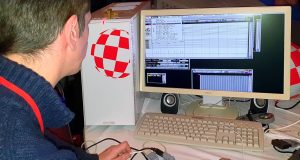
I’m sure Lyle Hazelwood will be pleased that Michael Clarke of Psygnosis fame composed a tune using Lyle’s AmigaOS 4 version of Bars n Pipes. Even better, knowing my interest/obsession in all things Commodore, Mike presented me with a Commodore LED watch dating back to the mid 1970s.
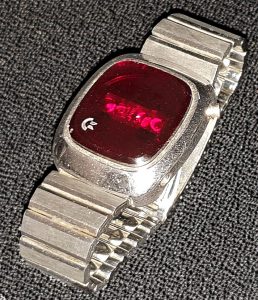
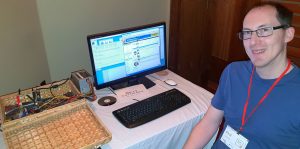
Meanwhile, driver wizard, Neil Cafferkey took the most unusual case prize for his AmigaOne X1000 wicker basket system on which he demonstrated the latest version of the A-EON sponsored wifi driver. Expect more news soon. Although the show was dominated by Classic Amiga machines there was good interest in the Tabor motherboard, especially from the Polish contingent at the show. Dan & Ravi from the Retro Hour Podcast gave a presentation and John Shawler of the Amigaos Podcast made the long trip from the USA. Michael Battilana of Cloanto also made another appearance.
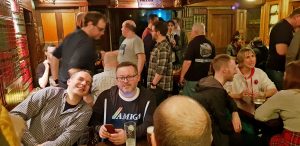
What can I say about Amiga Ireland? The show is an excellent mix of Amiga games, competitions, presentations and interviews. One of the best parts of Amiga Ireland is the Saturday night wind down after the show officially closes. It’s involves a trip to the local kebab/fish & chip shop for a quick bite to eat before heading to a private room booked by Iarla in a traditional Irish pub for discussions about preemptive multi-tasking and custom chipsets washed down with a liberal dose of local brew. Unfortunately this year Matthew, Christopher and I had to leave a little earlier than we would have liked as we had a 6:00 am drive back to Dublin airport. However this time it was me dragging Matthew the ”party animal” back to the hotel. 😉
From it’s initial inception four years ago the attendance has grown year on year and according to Iarla Reidy, the founder and organiser, the 2019 show officially attracted 99 visitors. While the attendance has continued to grow the event has lost none of its Irish warmth and charm which, when mixed with good Amiga people and fun makes it a winning combination.

The only complaint I have is the room was too small for the number of exhibitors and people who attended. 😉 It’s a great problem to have and Iarla has moved the venue to a larger room at the nearby Radisson Blu hotel for next year’s show which is set for the 17th & 18th January, 2020. I plan to attend again and hope to see many of you there too! 🙂 For more information please visit Amiga Ireland’s website.
Joining the legions of the undead
Way back in August 2013 I posted news that Igor Majstorovi was taking pre-orders for the Vampire 600, a new FPGA accelerator that he was developing for the Amiga 600.  Fast forward to 2019 and not only is the Vampire 600 available but a version also exits for the A500 with an A1200 Vampire waiting in the wings. Sold under the Apollo Accelerator brand, the Vampire is a Classic Amiga Accelerator that uses the Apollo core which is a code compatible Motorola M68K processor which is claimed to be 3 to 4 time faster than the fastest 68060 CPU. As each Vampire board is hand built there is a waiting list of eager Amigans so when I saw that Marvin Droogsma had a Revision 2.0 Vampire equipped A600 for sale at the Amiga Ireland show I was keen to add it to my collection.
Fast forward to 2019 and not only is the Vampire 600 available but a version also exits for the A500 with an A1200 Vampire waiting in the wings. Sold under the Apollo Accelerator brand, the Vampire is a Classic Amiga Accelerator that uses the Apollo core which is a code compatible Motorola M68K processor which is claimed to be 3 to 4 time faster than the fastest 68060 CPU. As each Vampire board is hand built there is a waiting list of eager Amigans so when I saw that Marvin Droogsma had a Revision 2.0 Vampire equipped A600 for sale at the Amiga Ireland show I was keen to add it to my collection.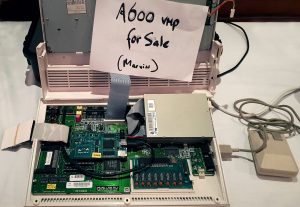 You might remember Marvin was the co-producer and MC of the highly successful Amiga 30th Anniversary show held in Amsterdam in 2015. However, I did not want to deprive another potential Vampire purchaser so I asked Marvin to let me know if the system remained unsold at the end of the show. Lucky for me it was still available and so I am now the proud owner of a Vampire accelerated A600. Incidentally, the silkscreen on the A600 motherboard is labelled as the A300 rev 1, further proof that the A600 was originally intended as a lower cost entry level Amiga. From revision 1.3 onwards the “June Bug” motherboards were relabeled as A600.
You might remember Marvin was the co-producer and MC of the highly successful Amiga 30th Anniversary show held in Amsterdam in 2015. However, I did not want to deprive another potential Vampire purchaser so I asked Marvin to let me know if the system remained unsold at the end of the show. Lucky for me it was still available and so I am now the proud owner of a Vampire accelerated A600. Incidentally, the silkscreen on the A600 motherboard is labelled as the A300 rev 1, further proof that the A600 was originally intended as a lower cost entry level Amiga. From revision 1.3 onwards the “June Bug” motherboards were relabeled as A600.
The Northern lights
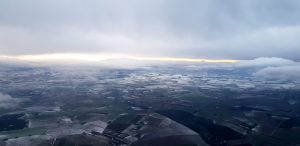
After the Athlone show we made our way back to Cardiff and the following day I travelled to snowy Aberdeen in north-east Scotland to attend the AGM of a small high-tech company of which I’m a minor shareholder along with some of my former business partners. I haven’t visited Aberdeen since 2011 and there has been many changes in the intervening years. The Western Peripheral Route has finally opened and, although not fully completed, has significantly reduced traffic congestion in the “Granite’ city.
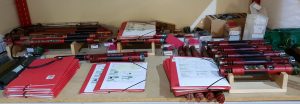
As the home to the UK oil & gas industry, Aberdeen has always been a prosperous city but the effects of the oil industry downturn are still very obvious. When the oil price plunges, motorists may benefit from lower petrol prices, but the international oil & gas industry reduces its costs by closing down operations and drastically laying off staff. It’s a brutal industry! My taxi driver previously worked for a specialist core analysis company in Aberdeen but was laid off two years ago at the height of the oil industry recession. It was still good to catch up with my old partners and we shared a whisky or two and put the world to rights. 🙂
Tabor News
After my short Aberdeen trip I returned to Cardiff and joined Matthew and AmigaOS 4 Team Lead, Steven Solie, who had flown in from Canada, in a meeting with the representative from the PCB manufacturing company that is coordinating the next Tabor motherboard run.
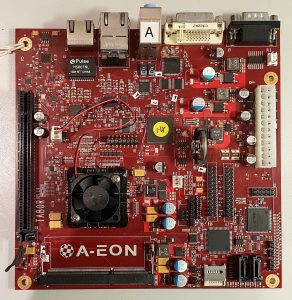
It was a good meeting and another step towards the production of the Tabor motherboards and the AmigaOne A1222’s official release. The company will manage the PCB production and organise the board re-spin which is needed to replace a few onboard components that are no longer available. Coincidentally, the PCB company has several facilities in the UK including one in Irvine, a town in North Ayrshire, Scotland where Commodore had its European Amiga 600s manufactured by Samina-SCI. It’s also the place where ESCOM set up a UK assembly and distribution base which supplied my first non-Amiga computer ESCOM PC, a very disappointing experience if the truth be told. Irvine was part of Scotland’s booming “Silicon Glen” economy which took a massive hit after the dotcom bust. In 2002, Samina-SCI closed down its Irvine plant with the loss of 750 jobs. Even more coincidentally, as a child I lived and went to school for several years about 7 miles from Irvine and later, after university, the first company I worked for had its headquarters nearby and I moved back into the area for a few years before the company relocated to Aberdeen.
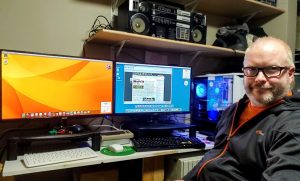
Meanwhile, getting back to Tabor. All round Amigan, Keith Dumoulin from Canada, has continued putting the AmigaOne A1222 through it paces. He borrowed Matthew’s prototype Tabor board to demo at the Toronto WOC Show in December last year but so far shows no signs of returning the board which is giving him a lot of fun. 😉 Keith has fairly typical Commodore & Amiga background. He started with a VIC 20, then upgraded to C64 on which he ran a two line BBS with a friend. He acquired his first Amiga in 1987 from a friend whose parents bought him an Amiga 1000 when he really wanted a Dell PC. (There’s no accounting for taste. ;-)) He bought the Amiga 1000 at a discounted price and the friend got the Dell PC he wanted. Keith became instantly hooked and after several upgrades eventually traded A1000 in for an A500. He put his A500 to good use, printing menus for a few local restaurant and got in digital signage. He upgraded and modded the A500 and, after he got his first credit card, purchased a brand new A1200 and external hard drive. He sold his A500 and used the funds to upgrade his A1200 adding a 68030 Accelerator and extra Fast Ram. He also purchased a second A1200 to provide digital adverts using a huge projector in a country music bar. Yee haw! Keith began acquiring and restoring Amigas for his own use and to help others and now has a complete collection of Classic Amiga models. For a couple of years he was a member of the core Vampire testing team but more recently has developed a passion for next-generation AmigaOne hardware.
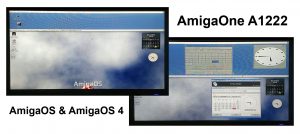
He acquired a Sam 460CR board to try out AmigaOS 4.1 and was very impressed with the performance of the OS. So much so that he is now the proud owner of an AmigaOne X5000 and a member of A-EON’s Amiga Developer beta test team.
Keith has been fine tuning UAE to optimise the performance of AmigaOS 3.9 on the AmigaOne X5000 and A1222. More recently he has also been comparing the performance of his AmigaOne X5000 running UAE 060 against his A4000 equipped with an 060@96 Warp Engine and Merlin RTG and CF card by running some classic Amiga demos.
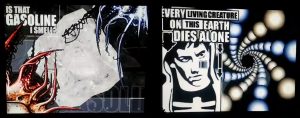
His conclusion: the X5000 can emulate a classic Amiga 060 running AmigaOS 3.9 with perfection. Of course most of the demos can be run directly under AmigaOS 4.1 and do not require UAE emulation, so why does Keith do it? And the answer is because with the AmigaOne X5000 and A1222 he can! 🙂
The French Connection
 While I was in Cardiff, Matthew and I also met with Laurent Zorawski and Jean-Luc of Amedia Computer who made the long journey from France to Cardiff to discuss possible future cooperation to help grow the Classic and next-generation Amiga market and user base in Europe.
While I was in Cardiff, Matthew and I also met with Laurent Zorawski and Jean-Luc of Amedia Computer who made the long journey from France to Cardiff to discuss possible future cooperation to help grow the Classic and next-generation Amiga market and user base in Europe.
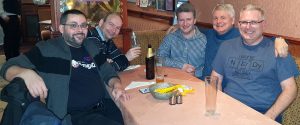
After our meeting I introduced Laurent and Jean-Luc to the joys of Welsh cuisine by taking them for an Indian curry! 😉 I think it was the first time Laurent had tasted spicy Indian food so we made sure it was a mild dish. I think they both enjoyed the meal but found my Chicken Vindaloo a bit too spicy. We tried an “interesting” locally brewed Welsh ale but they really enjoyed the Indian beer served in the restaurant. Anyway the meeting was really good and hopefully will lead to greater cooperation in the future.
SWAG Workbench 2019
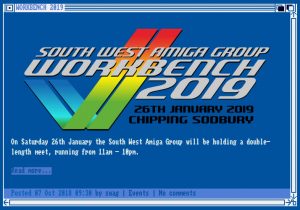 My final mission before returning to New Zealand was to attend SWAG’s (South West Amiga Group) Workbench 2019 mega club event in Chipping Sodbury, a short 25 minute drive north of Bristol. Unlike the Amiga Ireland show, Workbench 2019 was a special one-off double length club meeting running from 11 am to 10 pm for Amigans in the Bristol area of South West England. When I’m travelling around the world I always try to attend local Amiga gatherings if at all possible. SWAG’s Brian Hedley knew I was attending Amiga Ireland 2019 and contacted me in June last year to see if I could also attend their Workbench 2019 event.
My final mission before returning to New Zealand was to attend SWAG’s (South West Amiga Group) Workbench 2019 mega club event in Chipping Sodbury, a short 25 minute drive north of Bristol. Unlike the Amiga Ireland show, Workbench 2019 was a special one-off double length club meeting running from 11 am to 10 pm for Amigans in the Bristol area of South West England. When I’m travelling around the world I always try to attend local Amiga gatherings if at all possible. SWAG’s Brian Hedley knew I was attending Amiga Ireland 2019 and contacted me in June last year to see if I could also attend their Workbench 2019 event.
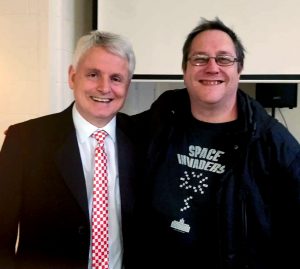
Since I needed to be in the UK for other business I rearranged my schedule to attend their user group meeting. Once again Matthew drove Steven Solie and I to the show, although we arrived 30 minutes late because we missed our motorway exit as Steven and Matthew were in deep Amiga discussions. 😉
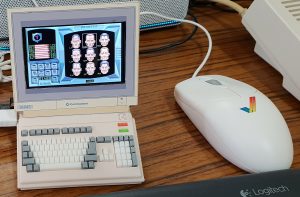
Workbench 2019 had all the traditional Amiga elements: Recap surgery for ailing Classic Amiga motherboards; a Speedball tournament run by Dave Rowland; the complete range of Classic Amiga models including an Amiga 1500 with its original box in almost mint condition and an incredible mini Amiga with monitor and custom made packaging.
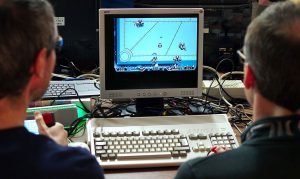
There was even a SWAG HAM radio station which was manned by Steve Netting but it was under utilised due adverse ionospheric conditions. Steve, who now works for Redhat, had travelled from Finland to attend the show and presented me with a nice bottle of Koskenkorva Salmiakki , a black Finish vodka with a salty liquorice taste. It was extremely moreish. It was also good to meet Radoslaw “Ferin” Czernik one of our AmigaOne X5000 beta testers from Poland. I also recognised Andy Costin the deputy Chairman of ANT, the Amiga North Thames user group. Several ANT members like Chris Forrester are also members of SWAG and helped to swell the numbers at the Workbench 2019 event.
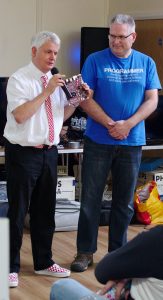
I gave a short presentation about my Amiga history and Steven Solie gave a brief overview of his long time involvement with AmigaOS 4 development, after which we jointly answered questions from the audience. During the Q/A session naturally I was asked for a Tabor update but it was question from Andy Costin which initially stumped me. He asked which Amiga would we rush in to save if our house was burning down. Steven said he had a fondness for his Sam460 and his AmigaOne X5000.
As I have a few machines I had to think long and hard but then I suddenly remembered the Kaikoura earthquake that hit New Zealand on November 14th, 2016. It was midnight and I had just got into bed. As I was trying to drift off to sleep the house began to shake. No problem I thought, it was just another earthquake and, like many others I had experienced since I moved to New Zealand, it would over soon. How wrong could I be! At a magnitude of 7.8 it turned out to be the second largest earthquake recorded in the last 150 years. Instead of dying down, after about 30 seconds the rumbling and shaking got more intense.
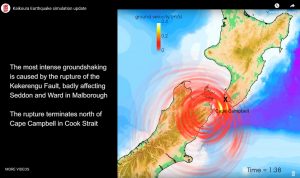
The house was now creaking and groaning and I could hear the metal shelves, in the room that housed my Commodore and Amiga collection, rattling loudly as the shaking became more violent. Books began falling off shelves and I heard a loud crash emanating from my office. I jumped out of bed and ran into my office and tried vainly to hold on to some the shelves as the whole house began to shake, twist and wobble. I knew it was time to get out when a Commodore 1942 monitor flew off one of the shelves. Realising I could not save any of the computers I ran back into the bedroom and grabbed my wife who, unbelievably, was still asleep in bed. We moved into the middle of the bedroom and like good Kiwis adopted the drop, cover and hold position. After about 2 minutes the noise and violent shaking reached a crescendo and then died down as quickly as it started.
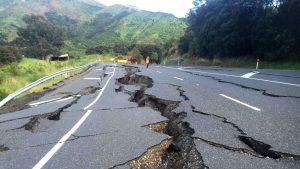
After the shaking subsided I discovered the power was out so I located a torch and went to survey the damage. Much to my wife’s ‘amusement’ I went to my office first to check on my computers. Apart from the 1942 monitor and a few other scattered items, my PowerPC iMac G5, a used machine I purchased in the hope that MorphOS would be ported to it one day, had also taken a dive and the screen was damaged. There was a nasty dent on the floor where the 1942 monitor had bounced but I later discovered it was still working. The rest of the house was OK although several glass and pottery items were broken. Our house is on the sea front and with the real risk of a tsunami we needed to get up to higher ground.
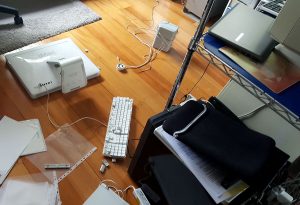
With the power off we could not open the electric gates to drive the car up the hill so we had to walk along the beach before we could head up to higher ground. Fortunately the tsunami never arrived although in one part of New Zealand it was measured at 6.9m. According to GeoNet, the earthquake caused 25 different faults to rupture (a world record) and triggered the biggest local-source tsunami recorded in New Zealand since 1947. It also caused extensive coastal uplift, widespread landslides and landslide dams. It was the second largest earthquake in New Zealand recorded in living memory and in the week after the quake we experienced almost continuous aftershocks with over 4,000 recorded and, for a time, it felt like the ground was continuously moving. Although our house, which is mainly a wooden construction and is designed to flex and bend, escaped damage, several major buildings in Wellington city were damaged beyond repair and were later demolished. So my answer to the question of which Amiga did I try to save? It was either all of them or none of them depending on your point of view. In the end I decided to save my wife! 😉
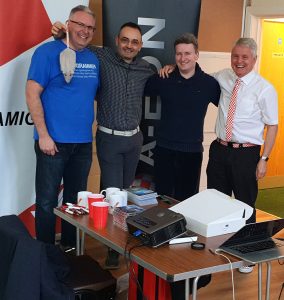
Anyway, back to the show. It was good to see both Victoria and Michael Battilana who also attended Amiga Ireland 2019 the previous weekend. I had a brief chat with ‘Amiga Richard’, another AmigaOne X5000 owner who is an integral part of the SWAG team. I know I often say this but I continue to be impressed by the sheer ingenuity and passion of the Amiga community and Workbench 2019 did not disappoint in that regard.
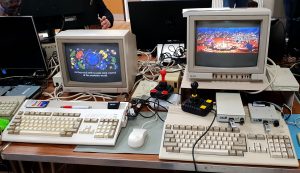
Unfortunately I could only stay for 4 hours as I was heading back to London to catch my flight home to New Zealand. The Workbench 2019 mega event was a great success with 45 people turning up on the day. It was supposed to be a one-off show but according to Brian the SWAG team are considering making it an annual event. I certainly hope they do. 🙂
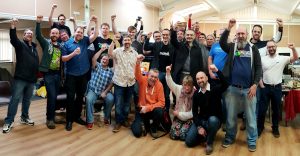
That’s all for now, back to New Zealand and summertime.